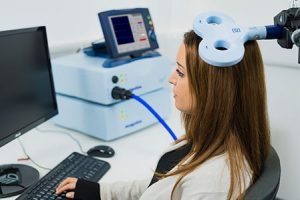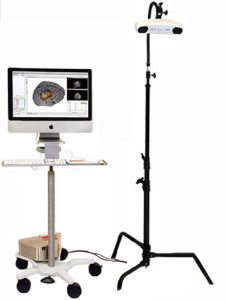Welcome to my blog. This page will provide a window into a research project being run as a collaboration between Imperial College, Imperial College Healthcare NHS Trust (ICHT) and the National Spinal Injuries Centre at Stoke Mandeville Hospital.
Our Project: Using TMS for Spinal Cord Injury
My name is Rowan, I am a physiotherapist at Imperial College Healthcare NHS Trust. I was successful in obtaining an Imperial Health Charity fellowship to undertake a research secondment at Imperial College in the Nick Davey Lab, part of the Imperial MSk lab, with Dr Paul Strutton. We are investigating the potential for transcranial magnetic stimulation (TMS), to be used as an assessment to help us understand the extent of spinal cord damage that has occurred after spinal cord injury. To use TMS, we place a coil next to a person’s scalp; an electric current is passed through the coil, generating a magnetic field. This magnetic field can activate the nervous tissue in the brain, creating different effects depending on the area of the brain being stimulated. TMS is safe, painless and has been used in research and clinical applications for over 30 years.
What can TMS Tell us? Assessing motor pathways

For the purposes of our research, we want to know if there is a connection between the muscles and the area of the brain that controls movement. To find this out, we will stimulate a brain area called the motor cortex and see if this leads to any activity in the muscles. We can measure this with stick-on electrodes. If we detect activity, this shows that there are connections from the brain to the muscles; that some of the spinal pathways are still intact. Knowing this could help patients and clinicians work out how much potential a person has to recover function. This could help with planning rehabilitation or targeting specific treatments.
Neuronavigated TMS and Protocol Development

We will use a special kind of TMS technique called neuronavigation, which uses infrared cameras to track the location of the coil and the person being stimulated. This means we can be very precise when we target the brain areas we are stimulating.
Our first task is to define the protocol that we will use with patients. To help us do that, we are recruiting healthy participants at our lab in White City in London and using TMS to map the responses from their arm and hand muscles when we stimulate the motor cortex. We want to know which parameters are most important, and how to carry out the protocol efficiently in a way that is comfortable for people with spinal cord injury. I will share more details about the experiment soon with pictures of the equipment so you can understand more what we are doing!
Patient and Public Involvement
We have also been talking to patients with spinal cord injury and their carers about our research. Through our contacts at the Spinal Injuries Association and with help from the NIHR Imperial Patient Experience Research Centre (PERC) we recently ran a Patient and Public Involvement (PPI) group session where we presented details about our project and received valuable feedback. I plan to write about this in a future blog post.
Stay Tuned!
I hope you have found this interesting. Stay tuned for more updates about the project. Please contact me via email if you have any questions or would like to take part in any of our experiments.
Further reading:
Klomjai, W., R. Katz, and A. Lackmy-Vallée, Basic principles of transcranial magnetic stimulation (TMS) and repetitive TMS (rTMS). Annals of Physical and Rehabilitation Medicine, 2015. 58(4): p. 208-213.
Arora, T., et al., Utility of transcranial magnetic stimulation in the assessment of spinal cord injury: Current status and future directions. Front Rehabil Sci, 2022. 3: p. 1005111.
Rossi, S., et al., Safety, ethical considerations, and application guidelines for the use of transcranial magnetic stimulation in clinical practice and research. Clinical Neurophysiology, 2009. 120(12): p. 2008-2039.
Hurrah! Finally I got a blog from where I know һow
to in fact take helpful facts cοncerning my ѕtudy and knowledge.